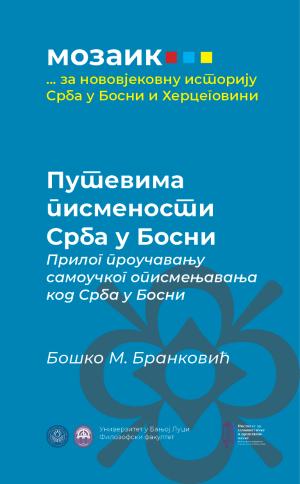On the Paths of Literacy among Serbs in Bosnia: A Contribution to the Study of Self-Taught Literacy among Serbs in Bosnia
Keywords:
Ottoman Empire, Bosnia, Serbs, literacy, educationSynopsis
WHEN WE STUDY THE HISTORY of the Serbian people in Bosnia, we can see how their past is connected to their efforts to preserve their military and national identity. One crucial factor in preserving identity during that time was literacy, specifically the ability to read and write. The position of the Serbian people in Bosnia under the Ottoman administration was difficult. The fate of the people followed the Serbian Orthodox Church, and everything related to it. Nevertheless, the historical work of Saint Sava was not destroyed after the fall of the medieval Bosnian state under Ottoman rule, on the contrary, it resonated as an echo among the Serbian people. It helped them persevere in keeping their faith, language, and history alive. In 1557, with the restoration of the Patriarchate of Peć, the spiritual unity of the Serbian people was established throughout the Ottoman Empire’s territory.
The Serbian church had set itself the task of teaching the Serbian people how to read and write. We can say successfully. Parish and monastery schools played a key role in preserving the literacy of the Serbian people during the Ottoman administration. The Cyrillic alphabet was also preserved as a script, and the Serbian language was not forgotten. Additionally, many Serbian books created in the Serbian medieval states were preserved and some new ones were also written.
The opening of Serbian schools in Bosnia Eyalet (or Pashalik) was a crucial step towards providing literacy for the Serbian people. Along with the Serbian church, the Serbian school became the most important element in connecting Serbian teachers, cultural workers, and later, political workers. Gradually, the Serbian school started to encompass all forms of secular life of the Serbian people in Bosnia. One of the most significant roles of the school is the preservation of national identity, ethnic and military affiliation, which proved to be especially important after the abolition of the Patriarchate of Peć in 1766. The Serbian school in Bosnia has a vital role in preserving the Serbian language, Cyrillic alphabet, and ethnic and military affiliation, in addition to providing literacy. The school deserves great credit for preserving and developing Serbian literature, particularly folk literature, during the Ottoman administration.
During the period of Austro-Hungarian occupation, Serbian confessional schools continued their mission to preserve the Serbian identity. They fought for the preservation of the Serbian language, script, and all that was created by the Serbian people in Bosnia in the past. Despite being in an unequal position compared to state (communal) schools, Serbian confessional schools also made efforts to increase the number of literate Serbs in Bosnia. Their struggle succeeded in making a positive impact on the Serbian people and taking a step forward in the right direction.
Finally, but no less important, in the field of Serbian literacy, self-taught individuals have made significant contributions that cannot be ignored. They are a noteworthy phenomenon in the history of Serbian education and literacy in Bosnia. Their efforts have helped to preserve Serbian folk literature and its creativity to a great extent. These individuals took on the responsibility of educating people in areas where traditional schools were not available. Their desire and determination to learn how to read and write themselves, and then pass on that knowledge to others, represents the strong spirit of the Serbian people. Despite the many challenges they faced under Ottoman and later Austro-Hungarian rule, the Serbian people had the fortitude to become literate and acquire the ability to read and write. It is safe to say that self-taught literacy is the best evidence of the Serbian people’s desire for cultural progress, both individually and collectively.
Downloads

Downloads
Published
Categories
License

This work is licensed under a Creative Commons Attribution-NonCommercial-NoDerivatives 4.0 International License.


